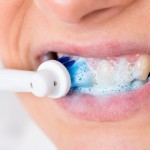
The erosive, ulcerative and atrophic forms of oral lichen planus (OLP) commonly present with gingival manifestations. More severe presentations are more likely to produce symptoms and pain, which affects patients’ lives. Current management of OLP is based on symptom management including oral hygiene control, and there is increasing interest in improving plaque control as a conservative strategy. The aim of this trial was to evaluate the impact of a structured plaque control intervention on clinical and patient-centred outcomes for patients with gingival manifestations of oral lichen planus.
Methods
Adult patients with a diagnosis of OLP were randomised to structured oral hygiene instruction using a powered toothbrush, with inter-dental cleaning aids or their normal plaque control regimen and did not receive this additional intervention or advice.
Primary outcome measure was oral health-related quality of life measured using the 49-item version of the Oral Health Impact Profile (OHIP-49). Secondary outcomes included visual analogue scales for pain, global transition scores and validated clinical indices for mucosal disease and plaque control along with evaluation of cost-effectiveness.
Results
- 82 patients (39 intervention and 43 control) were randomised.
- Mean age was 61.4 years at enrollment with 18.3% males to 81.7% females.
- The intervention patients showed statistically significant improvements in OHIP sum ordinal and OHIP dichotomous scores compared with control.
- At 4- weeks there were with significant differences between the intervention and control group in the domains of functional limitation, psychological discomfort and physical disability.
- The psychological disability domain showed significant differences at the 20-week but not at the 4-weeks.
- There was a significant improvement in mean plaque Index scores for the intervention group (39.5%) at the 20-week follow-up compared to the control group (4.1%).
- Improvements were observed using the mucosal disease indices at the 4- and 20-week follow-ups (p < 0.001).
Conclusions
The authors concluded:
A structured plaque control intervention was effective in improving the oral health-related quality of life and clinically observed gingival manifestations of oral lichen planus. This study provides evidence to include intensive plaque control within patients’ initial and on-going management. Intensive plaque control should, therefore, become an important initial phase of treatment, which can be delivered pre-referral by general dentists and dental hygienists.
Comments
As the authors note in their discussion the largest differences between groups were found with the psychological discomfort and physical disability domains and as these relate to being worried, self-conscious, miserable, concerned about appearance and tension this could be positively affected by participation in the study. While this would apply to both groups the additional advice and reassurance offered to the intervention group could have been beneficial. It has also been suggested that plaque control could contribute to development of new lesions, so the demonstration of improvement in the severity of OLP lesions in the intervention group is also worth noting.
Links
Stone SJ, Heasman PA, Staines KS, McCracken GI. The impact of structured plaque control for patients with gingival manifestations of oral lichen planus: a randomized controlled study. J Clin Periodontol. 2015 Apr;42(4):356-62. doi: 10.1111/jcpe.12385. Epub 2015 Apr 10. PubMed PMID: 25728699

Study finds better oral hygiene improved oral lichen planus http://t.co/EFf7ZQOrxN
Better oral hygiene improved oral lichen planus http://t.co/EFf7ZQOrxN
Quality of life improved for patients with OLP with better oral hygiene http://t.co/EFf7ZQOrxN
Better oral hygiene improved quality of life for OLP patients http://t.co/EFf7ZQOrxN
Don’t Miss – Better oral hygiene improved oral lichen planus http://t.co/EFf7ZQOrxN